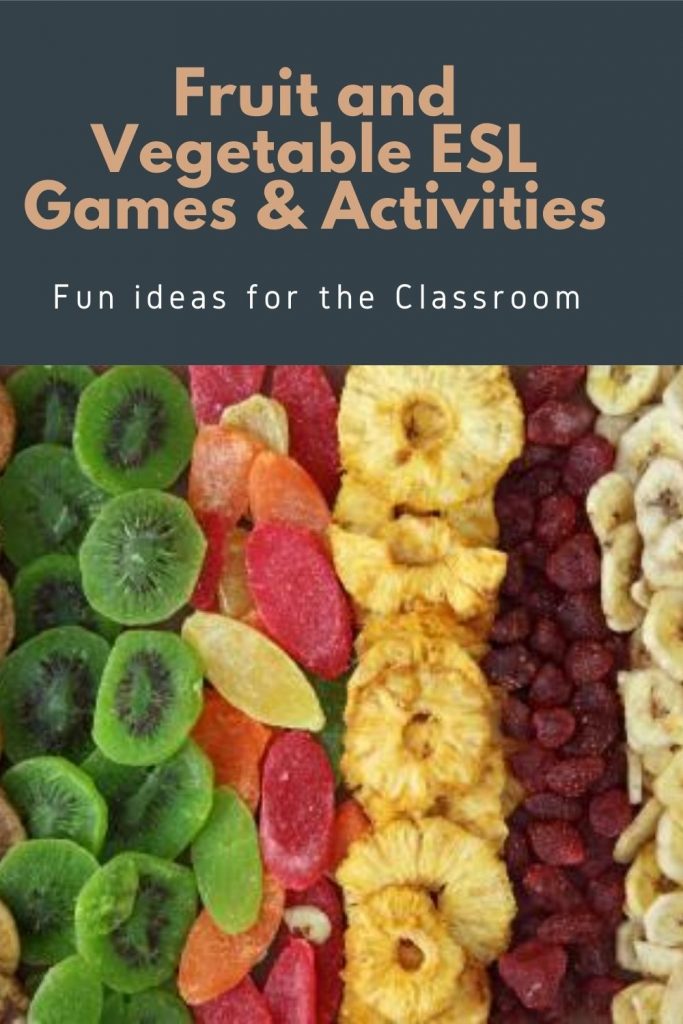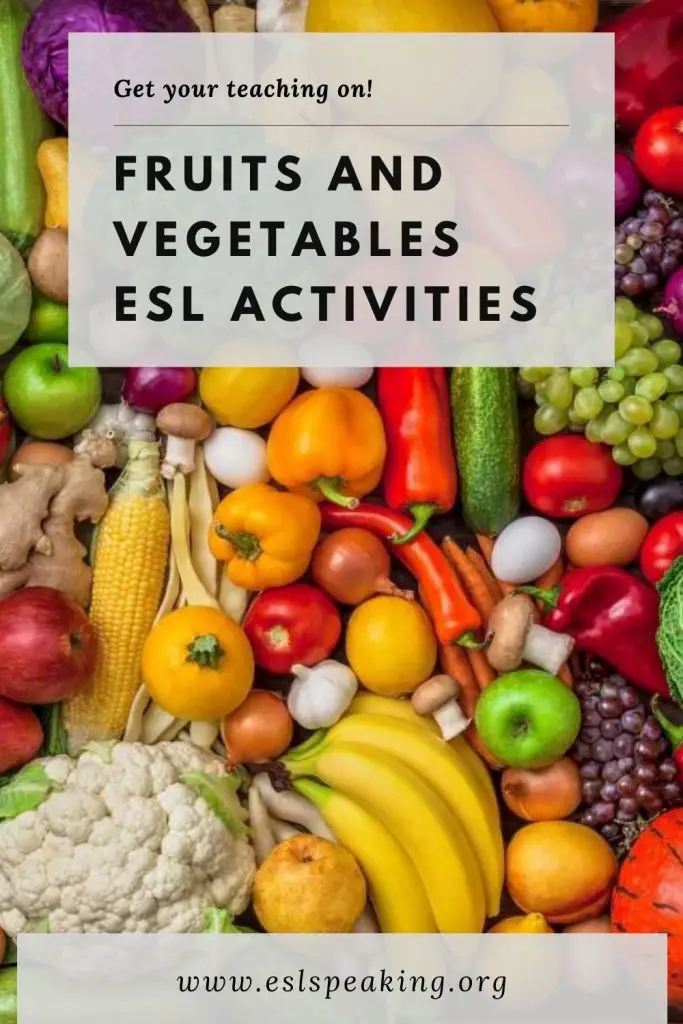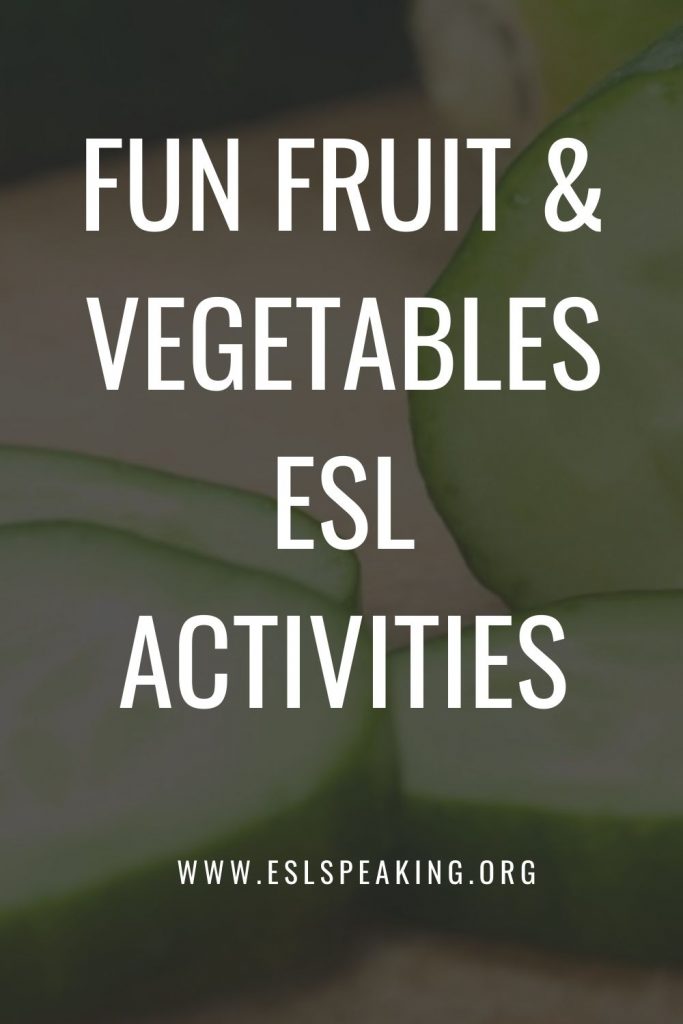If you’re looking for some fun, engaging and interactive fruit and vegetable games and activities for English learners, then you’re certainly in the right place. Keep on reading for our top options for veg games, along with lesson plans, worksheets and more.

Fruit and vegetable games
Fruit and Vegetables ESL Activities
Let’s get into the best ESL fruit and vegetable games and activities.
#1: Fruit and Vegetable Activity (quiz)
Try out one of my favourite fruit activities with your students:
#2: Running Dictation Vegetables and Fruit Game
If you teach slightly more advanced students, then consider using this challenging game in your class. It covers a ton of skills in a single activity and is ideal for just about any topic.
In this case, find (or write) a dialogue between two people talking about what vegetables and fruits they like or dislike. Or, their healthy or unhealthy eating habits. Then, students have to work together to dictate the dialogue and then put it into the correct order. Find out more about it:
#3: Fruits and Vegetables ESL Board Game
I love to play board games in real life so like to bring them into my classroom as well. It’s super easy to make your own for just about any topic, grammar point or vocabulary set in just a few minutes.
In this case, you may want to put pictures on the board and have students say what it is. Or, give hints and students have to guess the fruit or veggie. Finally, you could have a picture and students have to spell it out. Find out more about one of my favourite veg games here:
- Amazon Kindle Edition
- Bolen, Jackie (Author)
- English (Publication Language)
- 71 Pages - 10/26/2015 (Publication Date)
#4: ESL Fruit and Vegetable Bingo
Most students love to play Bingo and this topic is a natural fit for it. However, it’s not the most educational activity which is why I like to do this version which pumps up the listening and speaking elements of it. Find out my secrets for vegetables ESL made easy:
ESL Speaking and Listening Bingo.
#5: Vegetable Song for Kids
If you teach children, then you’ll definitely want to take full advantage of songs and chants for teaching new vocabulary like fruits and veggies. If you’re not musical (like me!), then not to worry. There are a ton of great options available on YouTube.
#6: Hot Potato Fruit and Vegetable Game
When teaching children, I love to play the hot potato game. There’s almost nothing like it in terms of pure excitement! The way it works is that the students pass around an object of some kind and when a timer goes off or the music stops, they have to answer a question of some kind. In this case, you could do any of the following:
- Show a flashcard and students have to say what the fruit or vegetable is
- Describe a vocabulary word and students have to guess what it is
- Spell a word
- Etc.
#7: Surveys for English Learners
Just ask my students and they’ll tell you that I love to use surveys in my classes. They’re student-centred and cover a range of skills in a single activity. It’s possible to make one in just a few minutes about healthy/unhealthy eating habits that use a ton of fruit and vegetable vocabulary words.
Want to give it a try? Learn about it here:
#8: ESL Fruit and Vegetable Apples to Apples
When teaching new vocabulary to my students, I love to play apples to apples with them. In this case, you’d want to make your own cards (or get students to help you do it) and make them heavy on fruits and vegetables. Find out all the details about this vegetable and fruit game:
#9: Telephone ESL Speaking Game
I’m sure you’ve played this game when you were a kid. The way it works is that students line up and then the teacher gives the first student a message. In this case, use lots of your target vocabulary words. Then, students pass the message down the line and the final student says it out loud. The results? Usually hilarious! Check it out:
#10: ESL Fruits and Veggies with Adverbs of Frequency
I find that a nice combination is fruit/veggie vocabulary along with adverbs of frequency (sometimes, once a week, never, etc.). It’s a natural fit and an easy concept for even young children to grasp. Find out some of the best ideas here:
Adverbs of Frequency ESL Activities.
#11: ESL Food and Drink Games and Activities
#12: What are you Cooking?
It’s sometimes tricky to teach adult beginners things like fruits and vegetables. Many of the games and activities are better suited for kids. However, one task-based learning activity to try out with adults is this one about cooking. It’s fun, engaging and ideal for reviewing new fruit and vegetable vocabulary words.
Sounds perfect for your students? Here are the details:
What are you Cooking ESL Task-Based Activity.
#13: Chain Spelling ESL Fruit and Vegetable Activity
A fun way to review the spelling of fruits and vegetables is this quick ESL spelling activity. All students stand up and then you say a word. They take turns spelling it out loud, letter by letter. If they miss, they sit down and are “out.” Continue until only 1-2 people are left standing. It’s one of my favourite vegetable and fruit games.
#14: Vegetable and Fruit Task-Based Learning (Presentation)
I like to incorporate some task-based learning into my English classes. In this case, consider putting students into groups and having them research a fruit or vegetable. Then, they can make a poster about it and give a short presentation to the class.
Adults can do the same but then give a few options for meals to consider making with their featured fruit or vegetable.
#15: What Am I?
This is a party game that involves asking questions about a post-it note on your back with a word on it that you can’t see. In this case, use fruit and veggies. It can be quite simple so be sure to have some extra ones for the students who guess their words right off the bat.
Learn more about one of the best vegetables games here:
#16: Odd One Out
#17: Comparatives and Superlatives with Fruits and Vegetables
A nice topic for comparative and superlatives is fruits and veggies, particularly if you bring some various-sized items into class with you. It’s easy for students to grasp, even young children or beginners. Find out some of my recommendations here:
ESL Superlatives and Comparatives.
#18: Fruit and Vegetable ESL Charades
A nice way to review this vocabulary is to play ESL charades. Include lots of things like:
- Peeling a banana
- Eating an apple
- Slicing a tomato
- Eating french fries
- Etc.
It’s one of the best fruit activities to try out with your students if you want to have some fun in class.
#19: ESL Flashcards with Fruits and Vegetables
In my opinion, flashcards are an often under-utilized ESL teaching tool. It’s possible to do a ton of activities with them and of course, fruits and vegetables, along with things like sports are often on them. Check out all the possibilities for fun fruit games here:
#20: Fruit and Vegetable Picture Prompt ESL Warm-Up
Unless you teach absolute beginners, it’s often the case that students already know a fair bit of fruit and vegetable English vocabulary. If this is the case, it’s helpful to do a warmer activity to help students activate their prior knowledge about a topic. This will make any new words more memorable.
One way to do this is to bring in a picture with lots of the target vocabulary in it. Then, ask students to tell you about what they see. It’s simple but effective.
#21: Dialogue Substitution
It’s often the case that new vocabulary is introduced through dialogue in ESL textbooks. However, it’s also common for students to just blow through it without really paying attention to what they’re reading. One way to avoid this is to remove some key words, in this case, fruits or veggies. Learn how to do this fruit and vegetable activity here:
#22: 20 Questions
This game is a natural fit for this topic. However, if you restrict it to only fruits or vegetables, then I make it into “10 questions” because 20 will be too easy. Find out more about this fun, challenging speaking and listening activity here:

Fruit and vegetable gams
#23: Flip-Chart Vocabulary Review Game
A fun way to review key vocabulary is to use this review game. The way it works is that a team has to describe a word to their captain, in English without using any sort of actions. It’s fun, and exciting and the students love it!
Try out one of my favourite vegetables games for yourself:
#24: List of Vegetables in English
#225: The Memory Circle with Fruits and Vegetables
When teaching kids new words, I like to use the memory circle as a way to review them. Students have to say a fruit or vegetable and then the game continues in a circle until students have added a new word, plus said all the other ones in order. Want to try it out? Here’s how it works:
#26: Typhoon Game
Use this game to review just about anything, including fruit and veggie vocabulary:
#27: Word Challenge ESL Spelling Game
I love to incorporate some spelling practice into my lessons and this is one of the most interesting ways to do it. It’s basically a whiteboard race that involves spelling out the fruit or veggies. You can say the word and have students spell it. Or, pump up the difficulty and gives hints until the students can figure out the secret thing and then write it down. Learn more about it:
#28: A to Z Alphabet Fruits and Vegetables Game
#29: Describing Something ESL Guessing Game
A fun warmer or review activity is to put a bunch of fruit and vegetable pictures on a PowerPoint slide. Then, students have to take turns describing one of them to their partner who has to guess what it is. Simple but a great way to review new words and get some speaking and listening practice in.
Here are the details:
Describe Something ESL Guessing Game.
#30: Use Realia
If you’re teaching about fruits and veggies, why use flashcards or pictures if you can use the real things? This is known as realia and it can make the lesson far more memorable. Let students touch, smell and taste!
#31: Dictogloss
#32: Vegetables and Fruits Pictionary
A fun vegetable and fruit game is Pictionary. Give students a slip of paper and they have to draw the fruit or vegetable that’s on it. Their teammates have to guess what it is. You can play 2 variations of this game:
- Timed rounds and students get as many points as possible.
- Each round consists of drawing only one thing and you time how long it takes.
#33: Fruit or Vegetable of the Week
When teaching children, I love to introduce a new fruit or veggie each week. I teach about the name, colour, how to describe it, etc.
Then, I bring it into class and students can see what it actually looks and feels like. I cut it up and everyone can try it! It’s a memorable way to teach fruits and vegetables.
#34: Fruit Quiz
How well do your students know the names of the fruits in English? Find out here with this fun quiz:
Vegetables and Fruit ESL Worksheets
A nice way to save lots of time is to just print off these fruit and veggie worksheets for your students instead of making your own. Here are some of the top choices for ESL vegetables and fruit:

Vegetable and fruit games and activities
Fruit Vegetables ESL Lesson Plans
If you’re a teacher then I’m sure you like to save time planning lessons. Who doesn’t, right? One of the best ways to do this is to use some ready-made lessons that you can just print off and take to class. Here are a few of my top recommendations for fruit and vegetable ESL lesson plans:
Online Practice for Fruit and Vegetables
My students always ask me where they can do some additional practice for what I’m teaching them in class. Here are some of my top recommendations for fruits and veggies online practice:
FAQs
There are a number of common questions that people have about teaching this unit. Here are the answers to some of the most popular ones.
What’s the difference between fruits and vegetables?
The difference between fruits and vegetables is that fruits contain seeds, while vegetables do not. Fruits are the ripened part of a flowering plant.
How do you explain fruit to preschoolers?
To explain fruit to preschoolers, bring in some samples. Tell students that fruits contain seeds and show them the seeds of the fruits you brought in. Explain that the skin can be rough, smooth, soft, or hard but that the inside is usually soft and juicy.
What are some fun games for teaching fruits and vegetables?
Some fun games for teaching fruits and vegetables include Pictionary and charades, Bingo, board games, songs and chants, along with spelling games.
Did you like these Vegetables and Fruit ESL Activities?
- Amazon Kindle Edition
- Bolen, Jackie (Author)
- English (Publication Language)
- 70 Pages - 11/28/2015 (Publication Date)
Yes? Thought so. Then you’re going to love this book over on Amazon: 39 ESL Vocabulary Activities for Kids. The key to better English classes for children is a wide variety of interesting, engaging activities and this book will help you get there in style.
You can find the book in both digital and print formats. Keep a copy on the bookshelf in your office to use as a handy reference guide when making lesson plans. Or, take the e-version with you on any device to your favourite coffee shop for some serious lesson planning on the go.
Either way, it’s some ESL teaching awesome. Head over to Amazon to find out all the details about it:
Have your say about these ESL Vegetable and Fruit Activities and Games
What’s your top pick for a vocabulary game for fruit or vegetables? Is it one of the options from this list or do you have your eye on another one? Leave a comment below and let us know what you think. We’d love to hear from you.
Also be sure to give this article a share on Facebook, Pinterest, or Twitter. It’ll help other busy English teachers, like yourself, find this useful resource.
Last update on 2025-04-17 / Affiliate links / Images from Amazon Product Advertising API







Leave a Reply